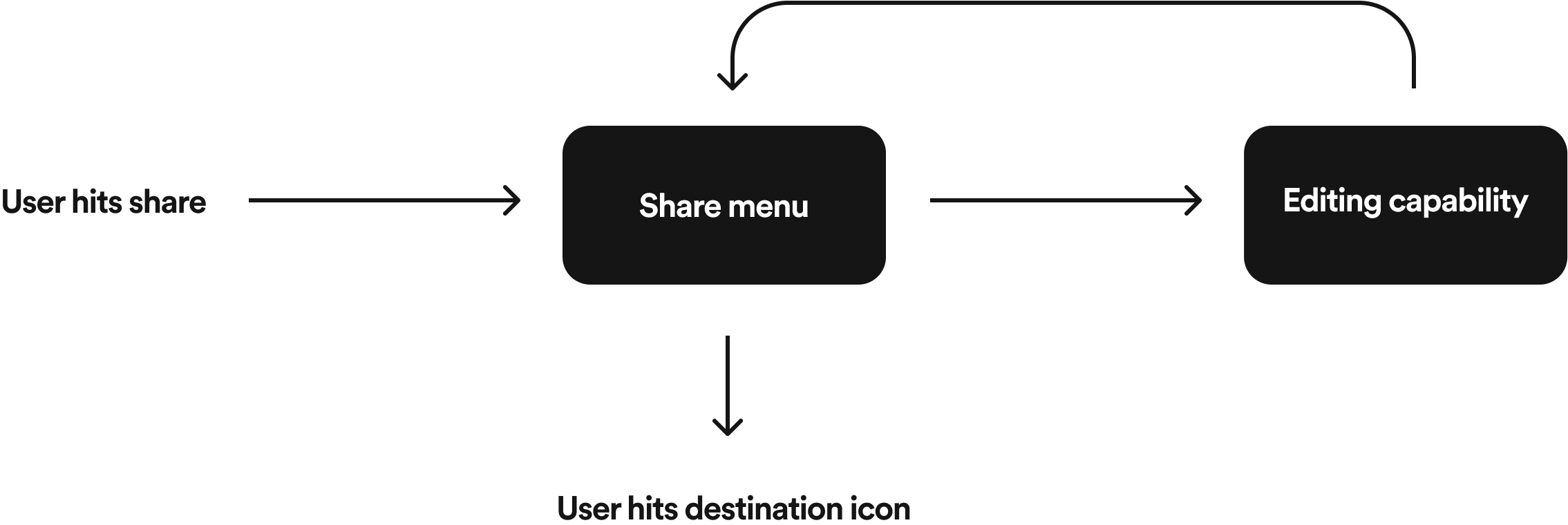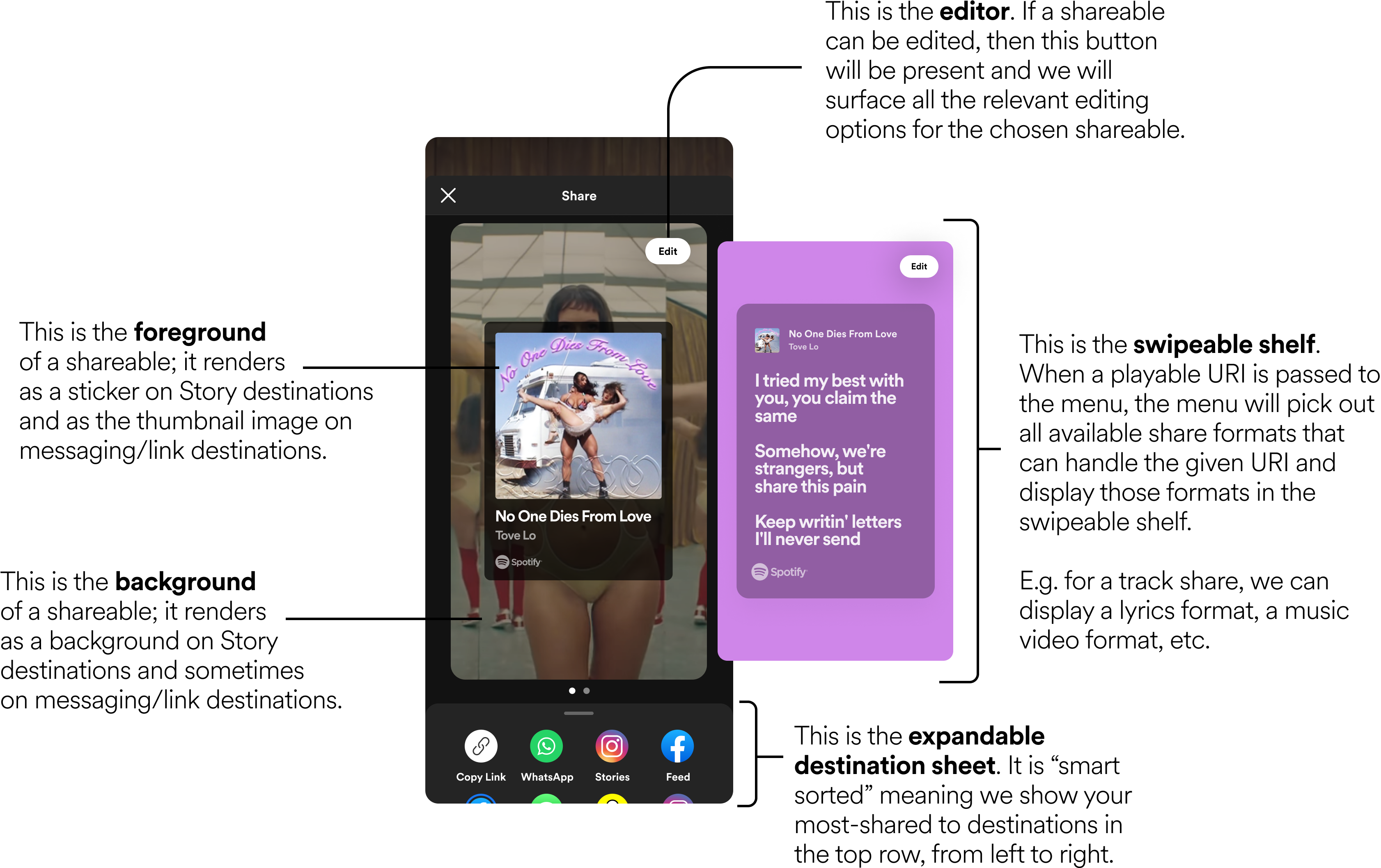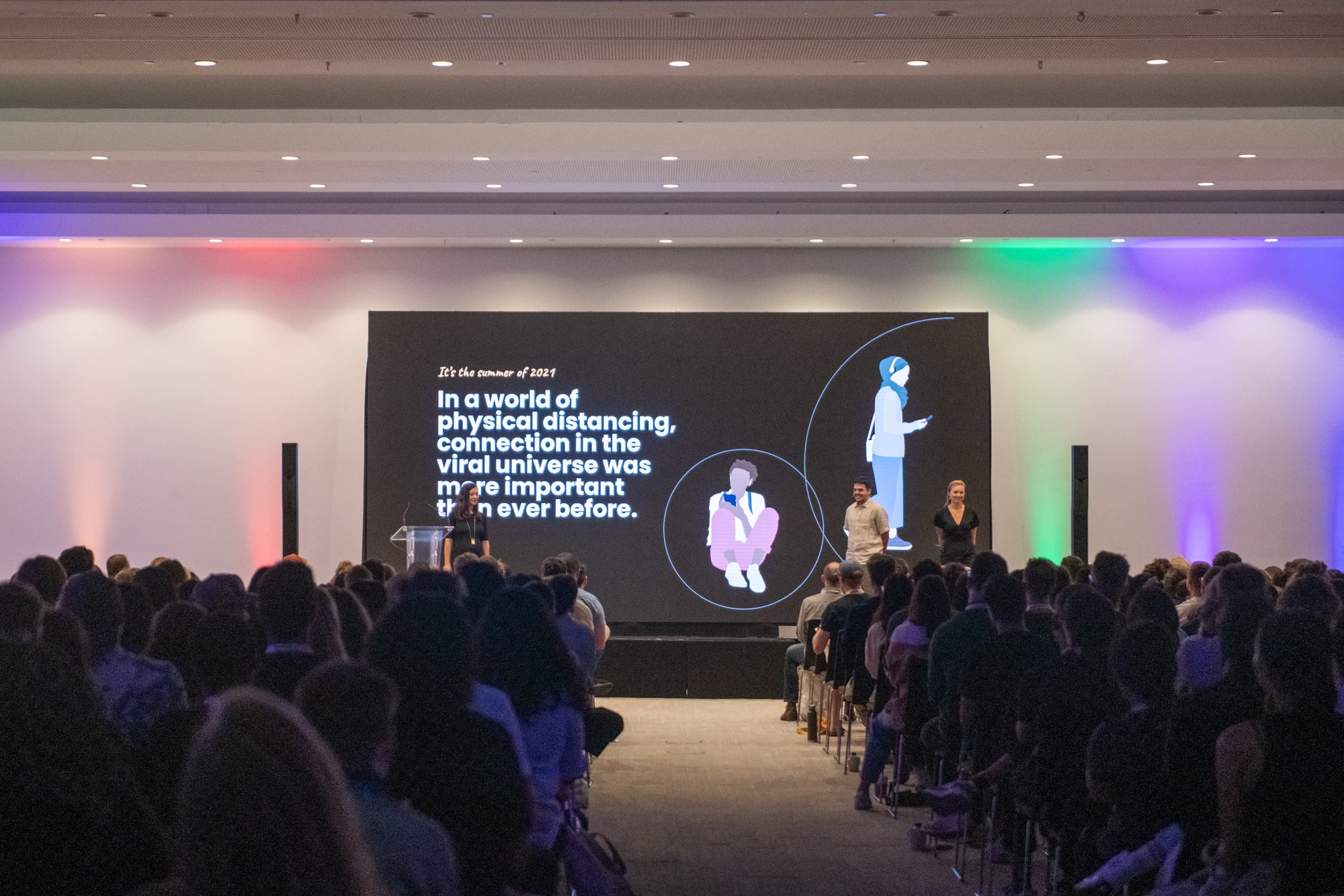︎ Work
︎ About
︎ Contact
René is a Stockholm-based product designer, currently crafting social experiences at Spotify. Before that, he was at Hugo & Marie, working with clients like The Row, Saint Laurent and STUDIOTWENTYSEVEN.

Re-defining the end-to-end sharing experience for millions of users
How we made it easier to share what you want, your way.
The TL;DR:
We built a new end-to-end sharing experience, to allow internal teams to make their features shareable, and to meet the growing needs of sharers and receivers of shared content. I was one of the leads driving design and design strategy.
We built a new end-to-end sharing experience, to allow internal teams to make their features shareable, and to meet the growing needs of sharers and receivers of shared content. I was one of the leads driving design and design strategy.
The impact:
- 🚀 Increase of shares, deeplink opens and 30s> streams;
- 🤳🏼 Unlocked new shareable content types, such as podcast chapters, transcripts, music videos (and my favorite - the daylist!);
- 🤝 Made it easier for internal feature teams to enable sharing of their content, saving costs for them;
- 🖼️ Unlocked creative customization for the first time, and;
- 🗂️ Spearheaded several insights initiatives, including the creation of a product insights repository with existing qual and quant sharing insights, to better access what we know and to reveal what we need to find out, and a rolling “highs/lows” research project to continuosuly understand our users and their needs.
The complete story:
The TL;DR: isn’t sharing just a button?
Yes, and that’s by design. We want it to make it easy for fans and creators to extend the Spotify experience beyond our own platform, to drive user grwth, brand affinity and creator growth.
But there was one problem: Spotify is huge, and more and more teams were building their own custom sharing experiences for their feature. This resuletd in a broken UX for users, and wasted resources for internal teams.
What’s the problem with sharing?
Sharing became a strategic priority in 2021 once it was clear that it was pivotal in driving the growth loop. Here’s why:
To summarize: sharing is a really big deal.
As new content offerings were increasing in Spotify, so were the demands to make them shareable to drive awareness and growth.
Therefore, several internal teams were building their own custom sharing solutions which resulted in different sharing experiences. Most shareable entities are shared through the main share menu, but on top of this there are several client features with their own bespoke share flows. This forced feature teams to spend unnecessary resources on building and maintaining their unique share flows. Entropy galore.
- Sharing contributes to a significant amount of new monthly regs and reactivations per month.
- These new registrations and reactivations account for some of the new Spotify MAUs (in Q4 2023, Spotify reported a total MAU of 574M).
- And a significant percentage of all Spotify MAUs being also sharing MAUs.
To summarize: sharing is a really big deal.
As new content offerings were increasing in Spotify, so were the demands to make them shareable to drive awareness and growth.
Therefore, several internal teams were building their own custom sharing solutions which resulted in different sharing experiences. Most shareable entities are shared through the main share menu, but on top of this there are several client features with their own bespoke share flows. This forced feature teams to spend unnecessary resources on building and maintaining their unique share flows. Entropy galore.
OK sure, but that’s the business problem. What were users saying?
On the other hand, users were were complaining about the inconsistent UX and the limited sharing capabilities available to them. With the changing landscape of the Inernet, content is king and users were expressing the need to customize and personalize their share. This is especially important when you share 1:1 or 1:few, where, as a sharer, you want to feel acknowledged and get feedback on what you have shared. But as a receiver, you are not very likely to open a share if the preview looks meh.
We had a big challenge ahead of us
We had a big challenge ahead of us

What do we already know?
We know a lot! Below is a high-level summary of the guiding insights, both qualitative and quantitative, that we sit on when it comes to sharing and receiving. The problem was that the old sharing and receiving experience didn’t live up to these truths.
I actually spearheaded the team’s first ever “rolling” research initiative to constantly learn about how our users are using our feature and to test our truths, but that is for another day!
I actually spearheaded the team’s first ever “rolling” research initiative to constantly learn about how our users are using our feature and to test our truths, but that is for another day!

How did you solve this?
To address this, the Sharing team built a more generic and scalable share menu, with the goal to collect all share flows in the same place. By doing this, we want to enable all teams internally to easily make their content shareable, while adhering to specific feature requirements by offering a flexible platform.
Testing, learning, iterating. And repeat
Together with some of the most talented user researchers I have ever worked with, we carried out a dozen rounds of both moderated and unmoderated usability research, to land on the final sharing design. Tweaks and iterations after each round of research meant we ended up with something that works beautifully and makes the most sense for our users.
Some of these research initiatives were more robust to understand and question our truths, others were more quick and dirty to quickly test a hypothesis.
Some of these research initiatives were more robust to understand and question our truths, others were more quick and dirty to quickly test a hypothesis.

First, the new share flows
From user research, it became clear that users share for a variety of reasons, and share a variety of things. And have a strong need to persoanlize and customize the thing they share, according to who and where they share to.
Different share formats require different capabilities. Which requires different flows. Some formats require editing before sharing, whilst others are ready to share right away. For the latter, editing should be optional as not to increase friction to share.
We needed to make it simple to just share what you intended to share, the way you want to.
The new sharing experience allows for different logics: upon hitting share, users can either be taken directly to an editor or to the share menu where they can pick their destination. This depends on each entry point and format.
Different share formats require different capabilities. Which requires different flows. Some formats require editing before sharing, whilst others are ready to share right away. For the latter, editing should be optional as not to increase friction to share.
We needed to make it simple to just share what you intended to share, the way you want to.
The new sharing experience allows for different logics: upon hitting share, users can either be taken directly to an editor or to the share menu where they can pick their destination. This depends on each entry point and format.
Logic 1: sharing, with the option to edit


Logic 2: sharing, but editing first


What does the new share menu consist of?

What about the editing capabilities?
The “Edit” entry point will house all the editing capabilities possible for a given share format. It is built with the flexibility of being a simple background picker, to a one-stop-shop for being able to edit the content of the shareable itself (e.g. pick new lyrics).
We took an iterative approach and began by building and testing the simple editor.
We took an iterative approach and began by building and testing the simple editor.

But what about the receiver experience?
Since sharing is a growth loop (person A shares > person B receives the share > person B opens the share > person B lands on Spotify), the receiver experience is as important as the sharing experience.
A smooth sharing experience means nothing if the receiver experience is broken.
We know that one big user pain-point is around the inconsistent previews/thumbnails on messaging platforms not accurately reflecting the content that is being shared (e.g. sharing lyrics via WhatsApp).
So we rolled up our sleeves and optimzed the preview experience for several content types like playlists and lyrics.
A smooth sharing experience means nothing if the receiver experience is broken.
We know that one big user pain-point is around the inconsistent previews/thumbnails on messaging platforms not accurately reflecting the content that is being shared (e.g. sharing lyrics via WhatsApp).
So we rolled up our sleeves and optimzed the preview experience for several content types like playlists and lyrics.

Who doesn’t love a good pitch?
This project brought on so many incredible opportunities. The biggest one being the opportunity to present in our annual Design Days conference in 2022, where 300+ designers from Spotify gathered in Barcelona to celebrate and learn from each other. I presented alongside my designer-partner-in-crime Hanna Norlin and our manager at the time, Oylum Serin.
I also created a pitch reel video using After Effects to give our vision life.
I also created a pitch reel video using After Effects to give our vision life.




Reflections, reflections, reflections
Being a feature team that so many teams depend on is no joke
Being a sharing evangelist meant I had to drive a lot of roadshows for other feature teams and senior leadership to get buy-in for this new sharing vision. I learnt how to advocate for sharing, our millions of users that use it and the immense business impact we have. It felt like being at a startup!
A bulletproof team can get through anything
Fundamentally, our sharing team is small, cross-disciplenary but mighty, built on years of experience, playfulness but most importantly - trust. I got to flex my Hyper Island education and help foster a stronger team culture, introducing new rituals to help improve our ways of working, and new ways of creating trust and radical candour. This meant that we overcame all the messy things that teams in large tech companies have to deal with.
Finding comfort in being a design lead
Getting to craft the end-to-end sharing and receiving experience, that affects huge cultural moments like Wrapped, meant that I was regularly dealing imposter syndrome. With time though, I learnt to put that aside and lean on my team and my domain expertise to bring about a world-class experience for such a fundamental part of the growth loop for Spotify.
Being a sharing evangelist meant I had to drive a lot of roadshows for other feature teams and senior leadership to get buy-in for this new sharing vision. I learnt how to advocate for sharing, our millions of users that use it and the immense business impact we have. It felt like being at a startup!
A bulletproof team can get through anything
Fundamentally, our sharing team is small, cross-disciplenary but mighty, built on years of experience, playfulness but most importantly - trust. I got to flex my Hyper Island education and help foster a stronger team culture, introducing new rituals to help improve our ways of working, and new ways of creating trust and radical candour. This meant that we overcame all the messy things that teams in large tech companies have to deal with.
Finding comfort in being a design lead
Getting to craft the end-to-end sharing and receiving experience, that affects huge cultural moments like Wrapped, meant that I was regularly dealing imposter syndrome. With time though, I learnt to put that aside and lean on my team and my domain expertise to bring about a world-class experience for such a fundamental part of the growth loop for Spotify.

